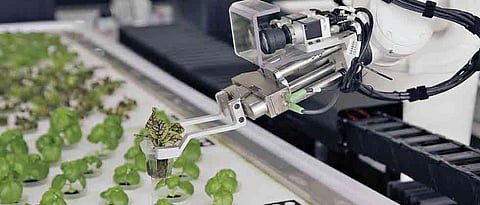

Will robots take over all tasks of humans, is a question often debated. Robots, backed by Artificial Intelligence, have started tending to farms. If robots, working round the clock, help get produce which is of good quality and cheaper, would it benefit humans?
Apparently yes, going by what Co-founder and CEO of Iron Ox, Brandon Alexander says. “If we can feed people using robots, what could be more impactful?” he told Associated Press (AP).
These robots work on farms located in warehouses or greenhouses and not traditional farms. So they are not a threat to jobs of farm labourers and are not going to replace traditional farming.
Iron Ox, a start-up based in San Carlos, California, US, raised $6 million and wants to build robot farms near cities to supply restaurants and supermarkets with fresh produce. It has set up a farm which is being tended to by robots in an 8,000-sq ft warehouse. Of course, the robots do not have humanoid bodies or faces.
There are two robots, a mobile one that can lift heavy loads and a robotic arm that does the delicate task of tending to the plants. The robot named Angus weighs 450 kg and can move loads up to 350 kg.
According to Fast Company, the mobile robot uses sensors similar to those in a self-driving car.
As a tray of plants matures, Angus carries it to the processing area where the robotic arm moves small plants in densely packed trays to containers with more space. This makes optimum use of space and the plants are given only the space they need and get more space as they grow. Alexander told CNBC that Iron Ox is able to do the equivalent of 30 acres of outdoor farming in just a single acre on its robotic farm.
The start-up uses a hydroponic growing system, with no soil and 90% less water than traditional farming. Alexander told AP the aim is to raise lettuce, basil and other produce in metropolitan areas and later other crops like tomatoes.
“We designed the entire process, from the beginning, around robotics,” Alexander told Fast Company. “It required us pretty much going back to the drawing board to see what we could do if robots were in the loop.”
A cloud-based ‘brain’ monitors the farm and directs the robots. The company’s team of plant scientists is working with its engineers to build algorithms for the robot to identify plant diseases. Ultimately, the farm will run completely on its own; plant scientists and roboticists will oversee the system, but won’t be necessary.
Most of the vegetables and fruits consumed in the US are grown at faraway places, so the consumers get produce that is nearly a week old. So the USP of Iron Ox is that it offers fresh produce at competitive prices from locations near the city.
The million dollar question is whether it will be economically viable. Iron Ox plans to set up robot farms in greenhouses that will rely on sunlight instead of costly lighting. Eventually, Iron Ox hopes to grow produce at a lower price than conventional farms.
In India, there is still time for robotic technology to be applied to farming. Instead of lettuce, the farm would have to focus on costlier produce to make it viable. Robot farms are not expected to replace traditional farming. However, they could contribute as a valuable source of food across the world.
